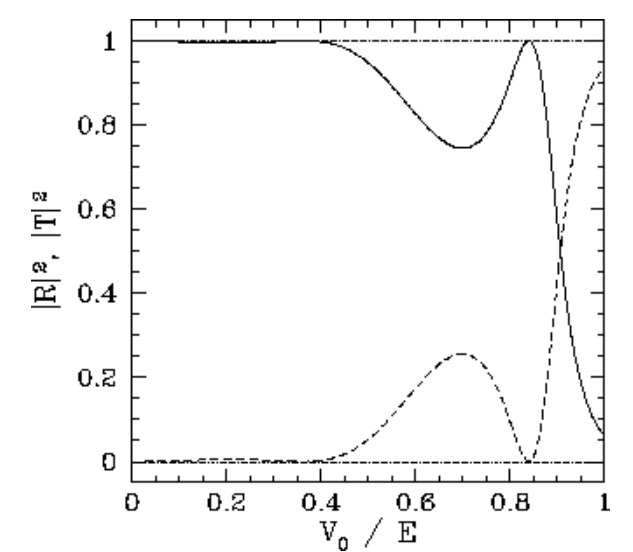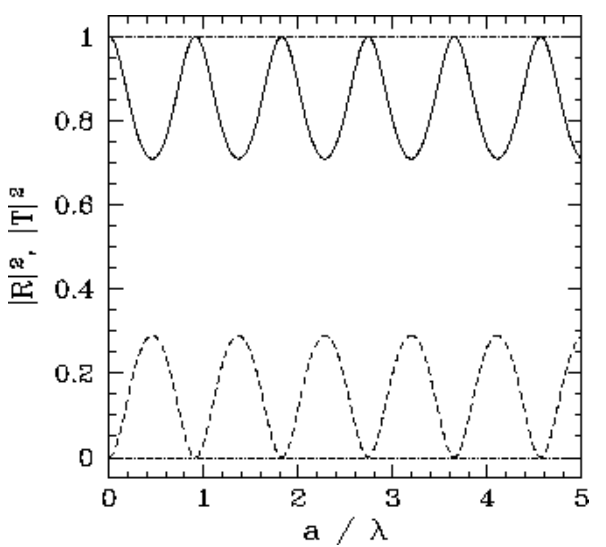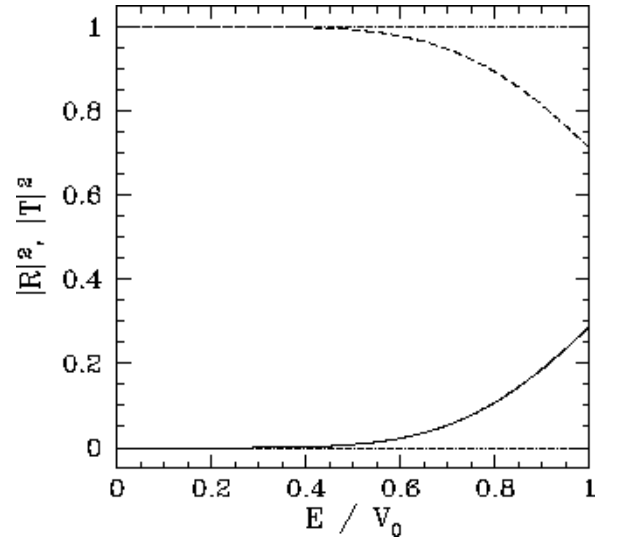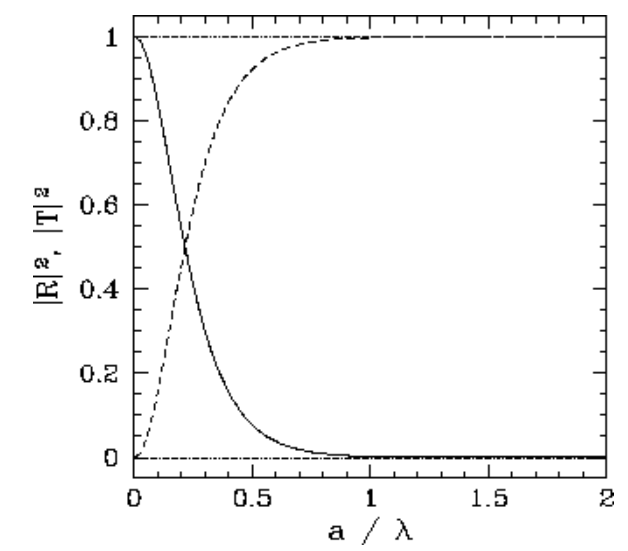4.2: Square Potential Barrier
( \newcommand{\kernel}{\mathrm{null}\,}\)
Consider a particle of mass m and energy E>0 interacting with the simple square potential barrier
V(x)={V0 for 0≤x≤a0 otherwise
where V0>0. In the regions to the left and to the right of the barrier, ψ(x) satisfies d2ψdx2=−k2ψ, where k is given by Equation ([e5.6]).
Let us adopt the following solution of the previous equation to the left of the barrier (i.e., x<0): ψ(x)=eikx+Re−ikx. This solution consists of a plane-wave of unit amplitude traveling to the right [because the time-dependent wavefunction is multiplied by exp(−iωt), where ω=E/ℏ>0], and a plane wave of complex amplitude R traveling to the left. We interpret the first plane wave as an incoming particle (or, rather, a stream of incoming particles), and the second as a particle (or stream of particles) reflected by the potential barrier. Hence, |R|2 is the probability of reflection. This can be seen by calculating the probability current ([eprobc]) in the region x<0, which takes the form jl=v(1−|R|2), where v=p/m=ℏk/m is the classical particle velocity.
Let us adopt the following solution to Equation ([e5.15]) to the right of the barrier (i.e. x>a): ψ(x)=Teikx. This solution consists of a plane-wave of complex amplitude T traveling to the right. We interpret this as a particle (or stream of particles) transmitted through the barrier. Hence, |T|2 is the probability of transmission. The probability current in the region x>a takes the form jr=v|T|2. Now, according to Equation ([ediffp]), in a stationary state (i.e., ∂|ψ|2/∂t=0), the probability current is a spatial constant (i.e., ∂j/∂x=0). Hence, we must have jl=jr, or |R|2+|T|2=1. In other words, the probabilities of reflection and transmission sum to unity, as must be the case, because reflection and transmission are the only possible outcomes for a particle incident on the barrier.
Inside the barrier (i.e., 0≤x≤a), ψ(x) satisfies d2ψdx2=−q2ψ, where q2=2m(E−V0)ℏ2.
Let us, first of all, consider the case where E>V0. In this case, the general solution to Equation ([e5.21]) inside the barrier takes the form ψ(x)=Aeiqx+Be−iqx, where q=√2m(E−V0)/ℏ2.
Now, the boundary conditions at the edges of the barrier (i.e., at x=0 and x=a) are that ψ and dψ/dx are both continuous. These boundary conditions ensure that the probability current ([eprobc]) remains finite and continuous across the edges of the boundary, as must be the case if it is to be a spatial constant.
Continuity of ψ and dψ/dx at the left edge of the barrier (i.e., x=0) yields 1+R=A+B,k(1−R)=q(A−B). Likewise, continuity of ψ and dψ/dx at the right edge of the barrier (i.e., x=a) gives Aeiqa+Be−iqa=Teika,q(Aeiqa−Be−iqa)=kTeika. After considerable algebra, the previous four equations yield |R|2=(k2−q2)2sin2(qa)4k2q2+(k2−q2)2sin2(qa), and |T|2=4k2q24k2q2+(k2−q2)2sin2(qa). Note that the previous two expression satisfy the constraint ([e5.20]).
It is instructive to compare the quantum mechanical probabilities of reflection and transmission—([e5.28]) and ([e5.29]), respectively—with those derived from classical physics. Now, according to classical physics, if a particle of energy E is incident on a potential barrier of height V0<E then the particle slows down as it passes through the barrier, but is otherwise unaffected. In other words, the classical probability of reflection is zero, and the classical probability of transmission is unity.

Figure 10: Transmission (solid-curve) and reflection (dashed-curve) probabilities for a square potential barrier of width a=1.25λ, where λ the free-space de Broglie wavelength, as a function of the ratio of the height of the barrier, V0, to the energy, E, of the incident particle.

Figure 11: Transmission (solid-curve) and reflection (dashed-curve) probabilities for a particle of energy ![]() incident on a square potential barrier of height V0=0.75E, as a function of the ratio of the width of the barrier, a, to the free-space de Broglie wavelength, λ
incident on a square potential barrier of height V0=0.75E, as a function of the ratio of the width of the barrier, a, to the free-space de Broglie wavelength, λ
The reflection and transmission probabilities obtained from Equations ([e5.28]) and ([e5.29]), respectively, are plotted in Figures [fb1] and [fb2]. It can be seen, from Figure [fb1], that the classical result, |R|2=0 and |T|2=1, is obtained in the limit where the height of the barrier is relatively small (i.e., V0≪E). However, when V0 is of order E, there is a substantial probability that the incident particle will be reflected by the barrier. According to classical physics, reflection is impossible when V0<E.
It can also be seen, from Figure [fb2], that at certain barrier widths the probability of reflection goes to zero. It turns out that this is true irrespective of the energy of the incident particle. It is evident, from Equation ([e5.28]), that these special barrier widths correspond to qa=nπ, where n=1,2,3,⋯. In other words, the special barriers widths are integer multiples of half the de Broglie wavelength of the particle inside the barrier. There is no reflection at the special barrier widths because, at these widths, the backward traveling wave reflected from the left edge of the barrier interferes destructively with the similar wave reflected from the right edge of the barrier to give zero net reflected wave.
Let us, now, consider the case E<V0. In this case, the general solution to Equation ([e5.21]) inside the barrier takes the form ψ(x)=Aeqx+Be−qx, where q=√2m(V0−E)/ℏ2. Continuity of ψ and dψ/dx at the left edge of the barrier (i.e., x=0) yields 1+R=A+B,ik(1−R)=q(A−B). Likewise, continuity of ψ and dψ/dx at the right edge of the barrier (i.e., x=a) gives Aeqa+Be−qa=Teika,q(Aeqa−Be−qa)=ikTeika. After considerable algebra, the previous four equations yield |R|2=(k2+q2)2sinh2(qa)4k2q2+(k2+q2)2sinh2(qa), and |T|2=4k2q24k2q2+(k2+q2)2sinh2(qa). These expressions can also be obtained from Equations ([e5.28]) and ([e5.29]) by making the substitution q→−iq. Note that Equations ([e5.36]) and ([e5.37]) satisfy the constraint ([e5.20]).
It is again instructive to compare the quantum mechanical probabilities of reflection and trans/-mission—([e5.36]) and ([e5.37]), respectively—with those derived from classical physics. Now, according to classical physics, if a particle of energy E is incident on a potential barrier of height V0>E then the particle is reflected. In other words, the classical probability of reflection is unity, and the classical probability of transmission is zero.

Figure 12: Transmission (solid-curve) and reflection (dashed-curve) probabilities for a square potential barrier of width a=0.5λ , where λ is the free-space de Broglie wavelength, as a function of the ratio of the energy, ![]() , of the incoming particle to the height, V0,of the barrier.
, of the incoming particle to the height, V0,of the barrier.

Figure 13: Transmission (solid-curve) and reflection (dashed-curve) probabilities for a particle of energy ![]() incident on a square potential barrier of height V0=(4/3)E, as a function of the ratio of the width of the barrier,
incident on a square potential barrier of height V0=(4/3)E, as a function of the ratio of the width of the barrier, ![]() , to the free-space de Broglie wavelength, λ
, to the free-space de Broglie wavelength, λ
The reflection and transmission probabilities obtained from Equations ([e5.36]) and ([e5.37]), respectively, are plotted in Figures [fb3] and [fb4]. It can be seen, from Figure [fb3], that the classical result, |R|2=1 and |T|2=0, is obtained for relatively thin barriers (i.e., qa∼1) in the limit where the height of the barrier is relatively large (i.e., V0≫E). However, when V0 is of order E, there is a substantial probability that the incident particle will be transmitted by the barrier. According to classical physics, transmission is impossible when V0>E.
It can also be seen, from Figure [fb4], that the transmission probability decays exponentially as the width of the barrier increases. Nevertheless, even for very wide barriers (i.e., qa≫1), there is a small but finite probability that a particle incident on the barrier will be transmitted. This phenomenon, which is inexplicable within the context of classical physics, is called tunneling.
Contributors and Attributions
Richard Fitzpatrick (Professor of Physics, The University of Texas at Austin)


